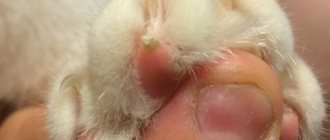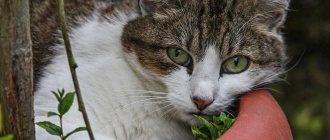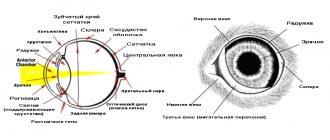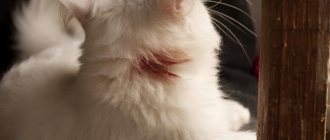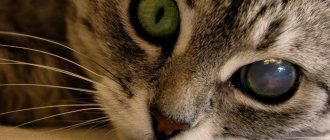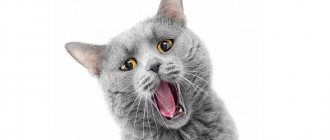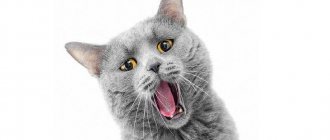Alena Igorevna Goncharenko
veterinarian Petstory
Mastitis in cats is a disease in which inflammation of the mammary gland occurs. This disease is mainly typical for young cats that have recently given birth. This condition requires immediate medical attention due to the fact that both the cat itself and its kittens can suffer.
Mastitis in a nursing cat: the main thing
- Most often, mastitis can be found in young lactating cats, less often in older cats and cats.
- Mastitis can occur either unnoticed by the owner or the cat itself, or with pronounced clinical symptoms.
- The diagnosis of “mastitis” can be made based on a general examination of the animal, but research will be required to clarify the nature of the inflammatory process.
- With a correct and timely diagnosis, treatment is not difficult.
Diagnostics
You cannot make a diagnosis and begin treating a cat on your own.
If the slightest signs of disease are detected, the cat should be taken to the veterinarian as soon as possible. The doctor will collect anamnesis and conduct a visual examination; the following may also be prescribed:
- general blood analysis;
- bacteriological examination of milk;
- study of mammary gland secretion cells.
Based on the test results, the diagnosis will be confirmed or refuted, and if necessary, the specialist will prescribe treatment.
Symptoms (with photos)
Detecting symptoms of mastitis is not easy because your pet's thick coat or because she may not allow you to examine and feel the belly.
It is important to monitor the condition of the animal, its well-being and changes in behavior, this is especially important in the period after birth and while feeding kittens.
The fact that the cat has started an inflammatory process is indicated by:
- painful and aggressive reaction to touch;
- licking the sore spot;
- increased temperature in the abdominal area;
Subsequently, the cat’s condition worsens, and symptoms such as:
- refusal to eat;
- depressed state of the animal;
- thirst;
- increase in body temperature.
It is also worth paying attention to the behavior of kittens - hungry babies will behave restlessly, they may have diarrhea, and during illness the cat may refuse to feed them.
Distinctive features
In addition to the above symptoms, visual signs can also indicate mastitis.
Due to the pathology, the nipples become enlarged, harden, covered with small cracks, swelling forms around them, and the area around the nipples turns red.
On palpation, lumps are felt in the nipples, and when expressing, a cheesy mass is released, pus or blood flows.
Types of mastitis
Lactational
Lactation mastitis develops soon after birth, while feeding kittens. At this time, the mammary gland is in the phase of its most active functioning. A large number of cavities appear in the mammary gland, which are filled with milk. These cavities are surrounded by fatty tissue. The vascular network is actively growing. All this is a favorable environment for the development of pathogenic microflora. Lactostasis, that is, milk stagnation, also contributes to the development of mastitis. For some reason (few kittens, a lot of milk) milk is not evacuated from the mammary gland quickly enough and stagnates. In such milk the risk of developing foreign infection also increases. Bacterial waste products can lead to fermentation of milk and the formation of clots. These clots can block the milk passages and lead to even greater congestion.
Non-lactational
This form of mastitis occurs in non-pregnant cats. The cause may be injuries in the mammary gland, the development of deep infection of the skin, fatty tissue and other nearby tissues, or the use of hormonal drugs.
Photo of mastitis in a cat
Spicy
It manifests itself with clear clinical symptoms: changes in skin color on the mammary gland, pain, swelling, and increased local temperature. The cat may be depressed or not show symptoms of illness. The milk may be red-brown, yellow-green, or remain white.
Chronic
Often the only symptom of chronic mastitis may be the kittens' reluctance to suckle from their mother. The cat may not show any signs of anxiety.
Catarrhal
If you palpate the mammary glands, you can find small lumps. After feeding the kittens or expressing milk, these balls disappear on their own. This course does not cause pain, high body temperature or other changes in cats. The main reason lies in stagnation of milk. This condition can also be called mastopathy.
Serous
The mammary gland becomes enlarged, swollen, and dense. During palpation, the cat may express painful sensations, and an increase in local temperature may be noted. If you try to express milk, a clear liquid will come out first, followed by milk. Milk may contain flaky inclusions.
Fibrinous
The gland is even more enlarged in volume, very dense. When palpated, the cat expresses serious dissatisfaction; sounds resembling crunching can be heard. With this sound, fibrin films that surrounded the mammary gland ducts and glandular tissue are destroyed. An increase in the size of the lymph nodes and an increase in overall body temperature can be noted. Along with the milk, flakes and films are released.
Hemorrhagic
This form of mastitis is characterized by hemorrhages in the breast tissue and adjacent tissue. The mammary gland is enlarged and painful. The milk turns pink or red and may contain blood clots.
Purulent
The cat's mammary gland is extremely painful and very dense. The skin may take on a pink or red tint. During palpation, the cat shows strong dissatisfaction. Purulent discharge from the nipples with a characteristic odor can be noted. Lymph nodes may be enlarged. The cat's general health may be unsatisfactory, she may be lethargic and refuse to eat.
Abscessing
Occurs in the absence of treatment for purulent mastitis. Cavities form inside the mammary gland and are filled with pus. Breast tissue begins to melt due to bacterial activity.
Gangrenous
This type of mastitis develops if anaerobic bacteria join the pathogenic microflora. They very quickly destroy mammary gland tissue and cause necrosis. You may notice a foul odor and a change in skin color to brown or black. Inflammation and infection spread to the tissue surrounding the mammary gland. If left untreated, this form of mastitis will cause serious complications to the cat and may die from sepsis.
Symptoms of the disease
It is very difficult to notice this disease at an early stage, especially if the animal has thick fluffy hair. The reason for a close examination is anxiety or refusal to feed the kittens.
Signs of mastitis:
- The mammary gland becomes hard to the touch and increases in size;
- The skin around the nipples turns red and its temperature rises;
- Cracks appear in the skin around the nipples;
- The animal avoids any touching of the nipples, as during this it experiences pain;
- The presence of blood or pus discharge from the nipples;
- The presence of discharge in the form of a curd mass from the nipples;
- General weakness and apathy;
- Increased body temperature;
- Poor appetite or complete refusal to eat.
If you have one or more of the above symptoms, you should contact your veterinarian to determine the stage of the disease and prescribe treatment.
Diagnostics
The owner can carry out the initial examination of the animal independently; special attention should be paid to the size and color of the nipples, as well as the nature of the discharge. If symptoms occur, it is recommended that you contact your veterinarian for a milk test.
Diagnosis of mastitis
Making the correct diagnosis (mastitis) begins with collecting a detailed medical history. If this is a cat that has recently given birth, you need to find out how the kittens are feeling, whether they are willing to eat, and whether they are showing signs of anxiety. It is also necessary to assess the condition of the cat itself, measure its temperature, palpate the mammary glands, evaluate the local temperature, swelling, density, skin color, pain, and the nature of the secretion.
Hurry up, choose a box and find out what gift awaits you
Discount on pet insurance
Promo code copied to clipboard
Laboratory diagnostic methods include blood tests. In clinical analysis, an increase in leukocytes and lymphopenia can be detected. With a pronounced process, a shift in the leukocyte formula to the left can be detected. In the biochemical analysis, there are no characteristic changes for mastitis; in some cases, an increase in transaminases may be detected; in an extremely severe condition, kidney indicators may be increased due to infection in them.
To assess the nature of the secretion secreted from the mammary glands, a cytological examination is performed. It can be used to detect the presence of blood cells, inflammatory cells, and bacteria in milk. Milk culture is also necessary to identify the type of pathogenic microorganism and titrate to antibiotics. In healthy animals, some bacteria are also found in the milk, but their abundant growth will indicate infection.
Causes of pathology
- Active secretion of milk. For this reason, milk begins to stagnate and sour, and this leads to the development of mastitis.
- Severe hypothermia of the chest. This is the most common cause of the disease, for example, your pet often walks outside or lies on a cold floor.
- Nipple injury. This happens for a variety of reasons, but most often because the kittens begin to scratch or bite their mother's nipples. This causes the cat's chest to become inflamed and begin to peel off.
cat mom
Complications
The main complications of mastitis include the development of an abscess or gangrenous form. With such forms of flow, the risk of damage to other tissues around the mammary gland (skin, muscles) increases. Milk becomes completely unsuitable for feeding kittens; they must be switched to a formula - a cat's milk substitute and fed by hand. Treatment of such forms of mastitis may involve surgery to wash out the pus and install a drainage system, removing necrotic tissue. If the entire breast is affected, complete excision of the breast tissue may be recommended. If left untreated, the cat may die due to sepsis.
Causes
The causes of mastitis in cats vary:
- Stagnation of milk due to increased productivity of the mammary glands or early weaning of kittens from their mother.
- General hypothermia of the animal or hypothermia of the mammary glands of a lactating cat.
- Injuries and bruises of the mammary glands or their nipples: cracks, scratches or bites. Traumatic lesions are a gateway for bacteria, viruses and fungi.
- Diseases of the genital organs during pregnancy or after childbirth.
- Abortion or cesarean section, after which the cat cannot feed the offspring for a long time.
- False pregnancy and other hormonal imbalances.
- Immunodeficiency.
- Failure of kittens to use all nipples. This happens if the cat has few kittens or some of the nipples have pathologies (tumors, injuries).
- Postpartum complications and complications after sterilization surgery.
How to express milk?
To effectively treat mastitis, it is necessary to prevent stagnation of milk. Along with milk, foreign bacteria are also eliminated. If it has been recommended to remove the kittens from the cat or if they cannot cope with the volume of milk, it is necessary to express it.
- Wash your hands thoroughly.
- If the cat is very active, you will need the help of another person to restrain it. The cat can be placed on your lap with its back to you, or fixed on a flat surface on its side. You can use blankets or towels to cover your cat to prevent injury from claws and teeth.
- Carry out a gentle massage of the mammary glands. It is necessary to do this without obvious effort, but try to knead the dense slices.
- Grasp the mammary gland with your index finger and thumb and gently squeeze until drops of milk appear.
- If it is difficult to let milk out this way, you should not use physical force. It is worth contacting your doctor and clarifying whether you are doing everything correctly.
You can also use a breast pump for women to express milk during mastitis, but its power may be too powerful for cats. Then you should make a breast pump yourself. To do this you will need a 20ml syringe. It is necessary to cut off its upper part (the one where the needle is attached) with a knife. Burn the cut edges over a fire so that they do not scratch the cat's skin. Next, you need to lean the cut part against the cat’s mammary gland and pull the piston so that a vacuum is formed. If you did everything correctly, milk will begin to be sucked into the syringe.
Treatment
Before taking any measures, you need to understand that the severe stage of mastitis cannot be treated independently.
Therefore, you can cure a cat yourself only at the stage of development of the disease.
Diagnostics
To prevent the development of the disease, you need to examine your cat more often. Namely, nipples to identify deviations. To do this, you need to pay attention to the following signs:
- soreness (does not allow you to stroke yourself in the abdominal area);
- swelling;
- high temperature in the area of the mammary glands;
- nipple discharge other than milk.
Treatment of mastitis
Treatment at a veterinary clinic.
Standard treatment at the veterinary clinic consists of the following injections:
- Intramuscular or intravenous calcium gluconate 10%, usually this injection is given once. But if the disease is advanced and purulent mastitis has already developed, then the injection is repeated after a couple of days.
- Novocaine blockade is a single injection of 0.5% or 1% novocaine. Novocaine is injected between the chest and abdominal cavity. The volume of the product is calculated as follows: 1 ml per kilogram of animal weight.
- Subcutaneous or intramuscular mastometrium. The drug is administered in small doses (0.5 ml).
At home
Be aware of the fact that self-treatment is allowed only in the early stages; in severe cases, you are not able to cure your pet.
What to do at home:
- If a nursing cat has mastitis, you can do a stroking massage. It should be performed only with smooth movements in the chest area.
- Treatment at home needs to be accelerated, so the breast must be isolated from the kittens and the external environment. To do this, you need to bandage the chest of the cats. But the bandage will cause her a lot of inconvenience, so it is better to shave the hair and cover the nipples with a bandage during treatment. The milk should not stagnate, so you need to express it periodically.
- Mastitis in a nulliparous cat can be treated as follows. Wrap the cotton wool in a bandage and then soak it in brewed oak bark, chamomile or sage. Be sure to let the broth cool to room temperature, otherwise you can burn your hands.
- Ichthyol oil is excellent for relieving inflammation. Place 2-3 drops of oil on clean hands, and then massage. Next, make a secure bandage so that the oil is well absorbed.
- Try to control how much water your pet consumes, otherwise treatment may slow down. She will also suffer because the pain will increase from excess milk.
Treatment with folk remedies is also allowed.
Mastitis
How to feed kittens with mastitis?
If the form of mastitis allows the cat to continue feeding the kittens on her own, then no changes in their diet need to be made. If your doctor has recommended that you temporarily or completely stop feeding your kittens milk, you should continue to feed them by hand. For this purpose, special mixtures are used - analogues of cat milk. The use of infant formula or other types of milk is possible only as a last resort; it has been proven that such kittens grow much worse and have more various diseases. This is due to the fact that the composition of milk of different animal species varies very significantly.
Prevention
Mastitis is a disease that can be prevented; for this it is important to comply with the following conditions:
- Try to control the amount of water you consume. This must be done before childbirth; if this is not done, then serous mastitis may begin to develop.
- Regularly clean the bedding on which your cat sleeps. You also need to follow hygiene rules, for example, try to treat your cat’s nipples with chlorhexidine at least once a day. This product kills most microorganisms, just be sure to remove the product dry after the procedure.
- Manicure all kittens, as the claws may be too sharp and can harm the nursing mother.
Treatment of mastitis in cats
The main drugs used to treat mastitis in cats are antibiotics. If the cat continues to feed kittens, it is necessary to use those antibiotics that can be given to small kittens. Usually these are antibiotics from the beta-lactam group. If other types of antibiotics are required, the kittens will need to be weaned and formula fed. The use of anti-inflammatory drugs also carries a risk of side effects in kittens. In some cases, the use of local anti-inflammatory drugs in the form of compresses or ointments may be indicated. Drugs that stop lactation can also be used.
In severe cases of mastitis, surgical intervention is used; dead tissue must be removed; in extreme situations, the mammary glands are removed entirely. For cats in serious condition, a venous catheter is installed, infusion therapy is performed, and inpatient observation is recommended.
Features and types of disease
Mastitis in cats is an inflammatory process in one or more mammary glands of a pet. A predisposition to this disease is observed in lactating cats. You need to be able to distinguish the signs of this disease, since the lack of qualified assistance contributes to the rapid progression of the disease. The danger is that mastitis can cause death in a sick animal. In addition, it is undesirable for small kittens to consume toxic milk from inflamed glands, as they can become poisoned and die.
There are two types of mastitis, which are distinguished depending on the stage of the disease:
- Catarrhal (serous) mastitis is a disease in the first stages, which can be easily treated and is characterized by the absence of severe symptoms;
- Purulent (abscessing) mastitis is complicated by the appearance of abscesses, resulting in increased treatment time.
With catarrhal mastitis, the general condition of the cat remains virtually unchanged. There may be lethargy and discharge of curdled liquid from the pet's nipples. Over time, against the background of the disease, an abscess and phlegmon develop, threatening the life of the animal. Animal owners are advised to seek help from a specialist at the first symptoms of the disease and not wait for complications to arise. Otherwise, treatment may be lengthy and ineffective.
Prevention of mastitis
Of course, mastitis, like any disease, is easier to prevent than to treat. Provide your pet with proper care, avoid hypothermia and injury. Give hormonal medications to your animal with caution and always consult a doctor about their use.
Carry out timely treatment against parasites, especially before pregnancy and childbirth. In a nursing cat, try to prevent congestion in one breast; at first, watch the babies so that they are applied to each nipple in turn for uniform emptying of the glands.
To prevent purulent mastitis, regularly wash or change the diaper where the cat and kittens are. Monitor the condition of each kitten’s claws and, if necessary, even trim the scratches so that the babies do not scratch the delicate skin near the mother cat’s nipples.
If scratches or cracks appear, wipe the skin with herbal decoctions and use special ointments to prevent infection. Pay enough attention to disease prevention and careful care of the animal.
We make an accurate diagnosis:
At the earliest stage, mastitis “behaves” secretly and quietly; it is completely impossible to notice it with the naked eye on your own. If you miss this time and start the disease, the cat’s health is in great danger. That is why it is so important to make an accurate diagnosis in time, identifying the reasons for which the disease arose.
Timely treatment depends on the pet owner. It is he who must carefully monitor the condition of the pregnant cat, then keep an eye on her, figuratively speaking, during the period of feeding the kittens and after the cubs are weaned from mother's milk, switching to regular food. The listed time is very dangerous in terms of mastitis for the mother cat. Having noticed at least one of the previously listed symptoms
, for example, fever, loss of appetite, lethargy, you must
call a veterinarian
to examine the animal.
By calling our emergency veterinary service and making a home call, a veterinary specialist will arrive at your place within 40 minutes with all the necessary documents and equipment. During the examination, he will ask when the kitten gave birth, whether there were any complications during pregnancy and birth, when the kittens were weaned, etc., related to this topic.
If the owner's suspicions are confirmed, tests will be carried out. Your veterinarian will conduct laboratory tests on nipple discharge. In this case, it becomes possible to determine the cause of mastitis. If this is the fault of bacteria, then the course of treatment will be completely different from that for mastitis caused by a fungal infection. An incorrect diagnosis and, as a result, incorrectly prescribed treatment can cause irreparable damage to the health of a four-legged patient.
